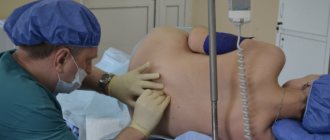Pregnancy is an exciting time for every woman. With the birth of a baby, a number of changes occur in a woman’s body. Bleeding during this period can seriously frighten a new mother.
Cost of services in our clinic
| Appointment with a gynecologist with the highest category | 1000 rub. |
| Consultative appointment with a doctor based on test results and ultrasound results | 500 rub. |
| Extended colposcopy | 1500 rub. |
| Amino test for bacterial vaginosis | 300 rub. |
| Medical abortion (all inclusive) | 4500 |
| Make an appointment by phone: 8-800-707-15-60 (toll-free) |
| *The clinic is licensed to remove tumors |
Don't be afraid. Discharge during the postpartum period is called lochia. This is a natural and normal phenomenon in the female body, unless, of course, postpartum complications begin.
What is lochia
Lochia is a vaginal discharge that appears after vaginal birth and cesarean section. Lochia consists of blood, mucus, placental tissue, as well as dying epithelium of the uterine cavity. If you think you have a discharge that doesn't look like lochia, tell your doctor.
Lochiometra and its treatment
For the treatment of lochiometry, the key is to remove the obstacle that interferes with the outflow of secretions. If the problem is poor contraction of the uterine muscles, the doctor will prescribe injections of the drug Oxytocin. It stimulates the contractile activity of the uterus. To relieve spasm in the external pharynx, use “No-shpu” or “Papaverine”.
It happens that a blockage occurs in the cervical canal. Blood clots and placental debris can clog it and interfere with the flow of fluid. In this case, a low-traumatic surgical intervention is indicated. During its course, the cervical canal is forcibly opened and cleared of contents.
As a home remedy for pain relief, gynecologists recommend applying ice to the lower abdomen and engaging in moderate physical activity. Even regular walking stimulates the uterus, causing it to contract.
Can discharge after childbirth stop and start again?
The intensity of discharge may fluctuate. But lochia cannot completely disappear and then appear again. Sometimes the bright bloody discharge that occurs in the first days after childbirth may return. In some cases, discharge may increase:
- In the morning after waking up
- During physical activity, for example when you do postpartum exercises.
- When you are breastfeeding.
Hygiene in the postpartum period
In order for the uterus to contract actively and return to normal size, hygiene in the postpartum period is very important:
- It is recommended to sleep on your stomach so that pressure on the uterus promotes its active contraction and stimulation of the outflow of lochia.
- You should immediately visit the toilet as soon as the woman feels the first urge, since a full bladder and a full rectum worsen uterine contractions.
- It is important to change the pad every two hours, since lochia is a suitable environment for the proliferation of pathogenic bacteria, which subsequently leads to infection.
- You should absolutely not use tampons at this time.
- Every day you need to wash yourself at least twice, using boiled water or a weak solution of potassium permanganate .
- It is worth practicing free feeding, putting the baby to the breast on demand, since when the nipples are stimulated, oxytocin .
What does discharge look like after childbirth?
It depends on how much time has passed since the day of birth.
- At first, the discharge is more abundant and darker in color.
- In the first few days after birth, lochia may also be abundant and have a bright red color.
- About a week after giving birth, the discharge may become pinkish or brown and not as heavy.
- After about two weeks, the discharge may turn light brown or yellow and the volume will noticeably decrease. Over time, the discharge will disappear completely.
Norms of blood loss during menstruation
Any woman should know how much monthly bleeding should be normal. This will help to detect pathology as early as possible, begin treatment and avoid dangerous consequences. It is impossible to say until the last drop how much blood a woman loses during menstruation; everything happens individually and depends on physiological characteristics. On average, this is 25-50 g per day, that is, in 5 days - 250 g maximum.
If there is more discharge and it also causes discomfort, it is important to consult a doctor as soon as possible. Normally, blood has a specific odor and is a dull burgundy color. Such characteristics are due to the inclusion in the secretions of endometrial particles, mucus and remnants of an unfertilized egg, which leaves the body along with the blood. The consistency of menstrual flow is not thick, but may include minor clots.
Main
Lochia is not the most pleasant accompanying circumstance during the postpartum period. But this is part of the whole process, and the discomfort will be temporary. Always carry spare pads with you, and at night, when the discharge is especially heavy, use highly absorbent pads. Your body will take some time to recover from childbirth and will go through various changes. And of course, the first days, weeks and months when you have to take care of your baby and yourself at the same time can be difficult and worrying. Feeling nervous and unsure about what is normal and what is not is completely natural at this stage, and don't hesitate to seek advice from your doctor. And the help and support of loved ones can especially help cope with the load during this difficult period.
Pathology
There can be many more pathological processes, all of them are associated with complications that occurred during childbirth or during pregnancy. What signs indicate that bleeding after childbirth is not normal?
- duration more than 1.5 months;
- scanty pink or brown discharge suddenly changes to intense scarlet discharge;
- deterioration of health;
- pain in the abdomen and back;
- dizziness;
- increased body temperature;
- nausea and vomiting;
- The discharge has a putrid or rotten odor, as well as an unnatural yellow or greenish tint.
It is better not to delay visiting a doctor; if the bleeding is life-threatening, do not hesitate, but call an ambulance.
If bleeding does not stop within a month after birth, this may indicate various kinds of complications.
How this article was written
The information presented in this article is based on expert advice published by trusted (medical and government) sources such as the American Pediatrics Association and the American College of Obstetricians and Gynecologists. A complete list of links to sources used to write this article can be found at the end of the article. The information on this page is not a substitute for professional medical advice. Always consult your doctor for diagnosis and treatment.
OBSTETRIC BLEEDINGS.
Emergency care at the prehospital stage
Obstetric hemorrhage is bleeding that occurs during pregnancy, childbirth, the afterbirth and early postpartum period.
Features of obstetric bleeding are:
- the massiveness and suddenness of their appearance;
- As a rule, during obstetric hemorrhage the fetus suffers, which dictates the need for urgent delivery and does not allow waiting for stable stabilization of hemodynamic parameters and full infusion-transfusion therapy;
- blood loss is often combined with severe pain;
- the peculiarities of pathophysiological changes in the body of pregnant women lead to the rapid depletion of compensatory and protective mechanisms, especially in pregnant women with complicated labor and late gestosis;
- Obstetric hemorrhages are characterized by an acute deficit of circulating blood volume (CBV), cardiac dysfunction, anemic and circulatory forms of hypoxia;
- There is often a danger of developing a detailed picture of disseminated intravascular coagulation (DIC) syndrome and massive bleeding.
The main causes of hemodynamic disturbances during obstetric hemorrhage are a deficiency of blood volume and a discrepancy between it and the capacity of the vascular bed. The resulting tissue hypoxia leads to disruption of redox processes with primary damage to the central nervous system, kidneys, liver, adrenal glands and other body systems. There is a violation of the water-electrolyte balance, acid-base balance (ABC), hormonal ratios, and enzymatic processes.
Obstetric hemorrhage is one of the leading causes of maternal mortality, accounting for 20–25% of its structure in its pure form, 42% as a competing cause, and up to 78% of cases as a background cause. The rate of obstetric hemorrhage ranges from 3 to 8% in relation to the total number of births, while 2–4% of obstetric hemorrhages are associated with uterine hypotension in the placenta and early postpartum period, about 1% of cases occur with premature abruption of a normally located placenta and placenta previa.
Possible causes of bleeding in obstetric practice are: termination of pregnancy of all stages, placenta previa, premature abruption of a normally located placenta, uterine rupture, rupture of the soft birth canal during childbirth, hypo- and atonic bleeding in the early postpartum period.
Hereditary or acquired defects of the hemostatic system can cause bleeding both during pregnancy and childbirth or in the postpartum period.
Among the causes of uterine bleeding associated with pregnancy, one of the first places is occupied by spontaneous abortion - termination of pregnancy in the first 22 weeks. Its causes can be various pathological conditions of the woman’s body.
Among the anatomical factors, infantilism, impaired development of the uterus, isthmic-cervical insufficiency, traumatic damage to the uterus during induced abortion or childbirth, and tumors should be highlighted.
Functional factors include infectious diseases suffered in childhood, induced abortions, inflammatory diseases of the genital organs, disruption of the functional state of the endocrine glands, a history of pathological childbirth, various frustrating situations, and extragenital pathology.
In addition, spontaneous abortion can be caused by disorders of the mother-placenta-fetus system and chromosomal disorders.
Features of an emergency condition during spontaneous abortion are:
- pain in the lower abdomen;
- spotting, which may take the form of bleeding;
- increased uterine tone;
- the presence of structural changes in the cervix, resulting in the opening of the uterine pharynx and the expulsion of the fertilized egg (in whole or in part).
The main directions of therapy depend on the stage of spontaneous abortion: threatened abortion, begun, abortion in progress, incomplete or complete spontaneous abortion.
- Pregnant women with any clinical form of abortion should be treated in a hospital.
- In the case of a threatening abortion that has begun (with minor bleeding), bed rest; drugs that help reduce contractile activity of the uterus (metacin, partusisten, ginipral, fenoterol, magnesium sulfate - cormagnesin, magnesium sulfate), and hormonal therapy as indicated (duphaston or utrogestan, dexamethasone or metipred). Treatment is carried out under dynamic ultrasound control (equipment from SHIMADZU, SIEMENS, TOSHIBA).
- In case of an abortion in progress and an incomplete abortion, curettage of the uterus;
in case of massive bleeding - blood transfusion. Therapeutic and tactical measures for spontaneous abortion at the prehospital stage (Fig. 1): - Assessment of the general condition of the pregnant woman, the degree of anemia, hemorrhagic shock according to the Algover index (shock index) and blood loss.
- Determining the duration of pregnancy and obstetric situation.
- Emergency delivery of a pregnant woman with spontaneous abortion to the gynecological department (patients are delivered to the hospital in a horizontal position).
Emergency care for pregnant women with miscarriage and significant blood loss at the prehospital stage is limited to the treatment of hemorrhagic shock. To treat hypovolemic shock, it is necessary to administer: polyoxidine 400 ml, or volecam 400 ml, or polyglucin 400 ml; then 400 ml of rheopolyglucin and 400 ml of gelatinol. The rate of intravenous administration of solutions is initially 20 ml/min, then in increments of 100–150 ml under the control of the lung condition and blood pressure. At the same time, other measures are taken to combat hemorrhagic shock. Infusion therapy is carried out until admission to the hospital. If there is a complete abortion, uterine contractions are administered: 1 ml of oxytocin intravenously in a stream with 10 ml of isotonic sodium chloride solution or 1 ml of methylergometrine (methylergobrevin) intravenously in a stream.
Bleeding in disturbed ectopic (ectopic) pregnancy
An ectopic (ectopic) pregnancy is a pregnancy in which a fertilized egg develops outside the uterine cavity.
According to localization, an ectopic pregnancy can be in the fallopian tube, ovary, cervix, in the rudimentary horn of a unicornuate uterus, in the abdominal cavity. According to the clinical course, it is progressive and disturbed in case of rupture of the external fetal sac (rupture of the tube, ovary) or internal (tubal abortion).
Risk factors for the development of ectopic pregnancy are: previous adnexitis, endomyometritis, abortion; violation of hormonal function of the ovaries; genital infantilism; endometriosis; undergone operations on the internal genital organs.
The leading symptom is spotting from the genital tract due to delayed menstruation, pain in the lower abdomen or signs of an acute abdomen.
Differential diagnosis: ectopic pregnancy; polyps, neoplasms, inflammatory processes in the cervix (the cause is identified during a gynecological examination - examination using mirrors); trophoblastic disease - the diagnosis is clarified by ultrasound (growths in the uterine cavity resembling bunches of grapes); dysmenorrhea.
Therapeutic and tactical measures for disturbed ectopic pregnancy:
- assessment of the patient’s general condition and the degree of blood loss;
- clarification of gynecological and obstetric history;
- urgent hospitalization to the gynecological department; transportation is carried out in a horizontal position with the head end down. During transportation, you should strive to maintain blood pressure at 80–100 mmHg. Art. In case of massive blood loss, hospitalization is carried out by the resuscitation-surgical team.
Emergency therapy at the prehospital stage includes infusion therapy: intravenous administration of 400 ml of polyoxidine or 400 ml of dextran (dextran, polyglucin, reopolidex), intravenous administration of 500 ml of a 5% glucose solution and 3 ml of a 5% ascorbic acid solution. Therapy with glucocorticoids and inhalation of oxygen and air through the KI-3M or “pneumocomp” (Medintech-M) devices according to indications.
Pregnancy and childbirth complicated by bleeding due to placenta previa
Placenta previa is a pathology of the placenta in which the placenta partially or completely covers the area of the internal os, i.e., it is in the path of the baby.
Predisposing factors: uterine scar; complicated obstetric and gynecological history; uterine fibroids.
The leading and only symptom: repeated uterine bleeding in the second half of pregnancy. Bleeding, as a rule, is preceded by repeated bloody discharge from the genital tract, which intensifies as the duration of pregnancy increases. Heavy bleeding begins suddenly, the presence of pain is not typical. Bleeding in a short period of time threatens to become massive - 1000-2000 ml. In a pregnant woman (mother in labor), the symptoms of hemorrhagic shock quickly increase, since the pregnant woman’s body’s resistance to blood loss is sharply reduced due to previous blood loss and the often developing post-hemorrhagic hypochromic anemia (hemoglobin less than 100 g/l).
Differential diagnosis: cervical pregnancy; premature detachment of a normally located placenta; uterine rupture; blood diseases; rupture of vaginal varicose veins.
Therapeutic and tactical measures at the prehospital stage (Fig. 2):
- Determination of the severity of the patient’s general condition (pulse rate, breathing rate, blood pressure, Algover shock index, skin color).
- Clarification of the obstetric situation (gestational age, presence or absence of regular labor).
- Detecting changes in the shape of the uterus, determining its tone, soreness, and the nature of the presenting part using a careful external examination. Vaginal examination is possible only with a full operating room due to the risk of developing profuse uterine bleeding.
- Assessment of fetal condition (movement, heartbeat).
- Assessment of the degree and nature of bleeding from the birth canal. During childbirth during full-term pregnancy, blood loss of 350–400 ml is considered maximum acceptable (borderline), since it can be compensated by the adaptive capabilities of the woman’s body; blood loss of more than 0.5% of the weight of a pregnant or parturient woman is considered pathological and requires therapeutic measures.
For minor bleeding, no treatment is required at the prehospital stage. In case of heavy bleeding, it is necessary to immediately begin infusion therapy aimed at replenishing the blood volume and stabilizing the woman’s condition. The high molecular weight and long-term circulation of dextrans in the blood make them preferable for massive blood loss: polyglucin 400 ml intravenously, gelatinol 400 ml intravenously; It is possible to use derivatives of these drugs. The use of starch solutions (infucol HES, refortan HES, stabizol HES, HAES) is more effective. The latest generation drug refortan HES - hydroxyethyl starch for intravenous infusion in the amount of 500 ml of 6% solution circulates in the vascular bed for a long time, has exclusively intravascular distribution, improves the rheological properties of blood and microcirculation, and is the least dangerous in terms of coagulopathies.
To reduce the contractile activity of the uterus, intramuscular administration of antispasmodics (drotaverine, no-shpa, spazoverine, spakovin) is indicated: 10 ml of a 25% solution of magnesium sulfate, 2 ml of a 2% solution of papaverine.
In order to prevent intrauterine fetal hypoxia, it is recommended to administer 20 ml of 40% glucose and 2–3 ml of 5% ascorbic acid solution intravenously, inhalation of an air-oxygen mixture of 40–60%.
Hemostatic therapy - dicynon or amben 2-4 ml intravenously.
The patient should be transported in a horizontal position; in full-term pregnancy, with the head of the body elevated to reduce respiratory failure.
A pregnant woman (parturient) with placenta previa should be taken to an obstetric hospital with intensive care and surgical departments. Obstetric hospital staff are required to be notified in advance of the admission of a seriously ill patient. Upon arrival at the hospital, the patient must be transferred directly to the doctor on duty.
Premature abruption of the normally located placenta (PONRP) is a pathology of pregnancy in which complete or partial detachment of the placenta from the walls of the uterus occurs during pregnancy or in the first or second stage of labor (i.e. before the birth of the child).
Predisposing factors: late gestosis, arterial hypertension, kidney disease, complicated obstetric and gynecological history, uterine fibroids, rapid uterine emptying with polyhydramnios, multiple pregnancies, large fetuses; abdominal injuries.
Clinical manifestations: severe pain in the lower abdomen in late pregnancy or childbirth; feeling of uterine tension; bleeding - external (from the birth canal), internal (in the area of retroplacental hematoma up to 500–1500 ml), combined; weakness, dizziness, malaise; pallor of the skin, tachycardia, arterial hypotension; significant reduction or disappearance of fetal movements.
Bleeding with PONRP is associated with a double violation of hemostasis due to a decrease in the contractility of the uterus, since the muscles of the wall are saturated with blood, and due to the development of disseminated intravascular coagulation syndrome.
The volume of total blood loss during PONRP can range from 600 to 2500 ml; a small volume of external blood loss may not correspond to the severity of the patient’s condition. With PONRP, a syndrome of multiple organ failure of such vital organs as the liver, kidneys, lungs, heart, and brain may develop, which is expressed in endogenous intoxication of the body, severe hypoxia and the development of discirculatory disorders in the lungs, kidneys, placenta, and uterus.
The fetus quickly develops symptoms of intrauterine hypoxia. When the placenta is separated by a third or more, the fetus always dies.
PONRP is differentiated from placenta previa, uterine rupture and other conditions accompanied by abdominal pain (acute appendicitis). With placenta previa, there is no pain or tension in the uterus, parts of the fetus are accessible for palpation, and its vital functions are usually not affected. In case of uterine rupture, there is a history of complicated abortions, childbirth, and previous uterine surgeries.
Tactics of the EMS doctor for PONRP (Fig. 3):
- Determination of the severity of the patient’s general condition (pulse rate, breathing rate, blood pressure, Algover shock index, skin color). It should be noted that blood pressure against the background of gestosis in the second half of pregnancy can be reduced to normal values, which masks the true nature of blood loss.
- Clarification of the obstetric situation (gestational age, presence or absence of regular labor, the nature of the appearance of pain in the uterus, their localization). It is necessary to identify changes in the shape of the uterus, determine its tone, soreness, the presence of symptoms of peritoneal irritation, the degree and nature of bleeding from the birth canal.
- Assessment of fetal condition (movement, heartbeat).
- Conducting prehospital infusion therapy for a pregnant woman (parturient) with PONRP, aimed at maintaining the function of vital organs and the central nervous system (similar to therapy for placenta previa).
A patient with PONRP must be immediately hospitalized at the nearest obstetric hospital.
Bleeding due to coagulopathy (DIC)
Causes: massive blood loss due to hypo- and atony of the uterus, premature abruption of a normally located placenta, amniotic fluid embolism, long-term (more than 2 weeks) stay of a dead fetus in the uterus, preeclampsia, uterine rupture, cesarean section.
Leading symptoms: increase in the volume of blood loss and severity of hemorrhagic shock, ineffectiveness of measures aimed at treating hypo- and atony of the uterus, the appearance of bruises at injection sites; blood flowing from the birth canal or into a wound during a cesarean section forms loose clots (in severe cases it does not clot); the uterus is dense, well contoured.
Emergency therapy is aimed at preventing or recovering from hemorrhagic shock. Therapeutic and tactical measures at the prehospital stage are aimed at emergency delivery of pregnant women (mothers in labor) to an obstetric hospital, equipped with a laboratory for studying blood coagulation parameters and having the capabilities for a dynamic study of a coagulogram, as well as an intensive care unit and qualified personnel to carry out treatment using surgical methods.
Patients are transported in a horizontal position under continuous monitoring of blood pressure, pulse rate, and respiration. A resuscitation and surgical team may be called in to help. Ventilation and oxygen-air inhalation are required. The obstetric hospital must be notified in advance of the arrival of a seriously ill pregnant woman or woman in labor.
Main directions of therapy:
- Treatment should begin with restoration of systemic hemodynamics by administering solutions with high molecular weight - ethoxylated starch (6% and 10% HAES-steril) at a rate of 10-20 mg/kg/h, volecam from 500 to 1000 ml, dextran solutions no more than 400 ml.
- Categorical refusal to administer heparin for the purpose of interrupting intravascular coagulation due to the lack of a clear diagnosis of the 1st phase of DIC and its transition to the 2nd phase of DIC.
- The use of protease inhibitors (aprotex, contrical, gordox) at a dose of at least 10 mg/kg/h to suppress excess fibrinolysis and prevent the progression of intravascular coagulation, antiplatelet action.
- Stimulation of the vascular-platelet component of hemostasis (dicinone or etamsylate) 4 ml, 0.5 g of active substance, intravenously.
- The use of tranexamic acid (transamcha, cyclo-F) - an antiplasmin drug in a dose of 500-750 mg in saline solution.
- Considering the development of hypoglycemia with massive blood loss, it is advisable to include solutions of concentrated carbohydrates (glucose 10–20%, 400 ml) in infusion-transfusion therapy. The introduction of these solutions not only contributes to the restoration of energy resources, but also potentiates the hemodynamic effect.
- In case of unstable hemodynamics and ongoing bleeding, glucocorticoid therapy is indicated - prednisolone at least 10 mg/kg/hour or hydrocortisone at least 100 mg/kg/day.
Hemorrhagic shock is a clinical category to designate critical conditions associated with acute blood loss, as a result of which a crisis of macro- and microcirculation, a syndrome of multiple organ and multisystem failure develops. The development of hemorrhagic shock is caused by hemorrhages exceeding 1000 ml, i.e. blood loss of more than 20% of the bcc (compensated stage); bleeding is considered massive if it exceeds 30–35% of the volume of blood volume - 1500 ml (decompensated reversible stage); blood loss of more than 50% of the bcc is a decompensated irreversible stage, such bleeding is life-threatening.
Features of hemorrhagic shock in obstetric pathology:
- Often accompanied by the development of DIC syndrome.
- Placenta previa is characterized by severe hypovolemia, arterial hypotension, and hypochromic posthemorrhagic anemia.
- It often develops against the background of a previous severe form of gestosis in pregnant women.
- With premature abruption of a normally located placenta, it is characterized by hypovolemia against the background of chronic vascular spasm, a chronic form of disseminated intravascular coagulation syndrome.
- Hemorrhagic shock, which develops as a result of hypotonic bleeding in the early postpartum period, is characterized by a short period of unstable compensation, after which irreversible changes quickly occur, characterized by persistent hemodynamic disturbances, respiratory failure and DIC syndrome with profuse bleeding caused by the consumption of blood coagulation factors and a sharp activation of fibrinolysis.
- With uterine rupture, symptoms of hypovolemia and insufficiency of external respiration are characteristic.
Treatment of hemorrhagic shock of obstetric etiology begins at the prehospital stage. The main measures for its treatment are as follows: carrying out obstetric care and local hemostasis operations; provision of anesthesia, elimination of respiratory failure; carrying out infusion-transfusion therapy aimed at restoring the composition, properties and bcc; elimination of acid-base disorders (ABS).
The patient is transported in a horizontal position with the head down, and infusion solutions are administered along the way. To reduce respiratory failure, oxygen is inhaled through the KI-3M or AN-8M apparatus; the patient can be given anesthesia with nitrous oxide and oxygen in a ratio of 1:2, and, if necessary, intubation and artificial ventilation.
Infusion and transfusion therapy is carried out according to an individual program for each patient, taking into account the characteristics of hemorrhagic shock characteristic of obstetric pathology; concomitant diseases (heart, kidneys, etc.); presence of signs of gestosis.
Treatment of hemorrhagic shock involves the administration of anti-shock solutions: polyoxidine 400 ml, or volecam 400 ml, or polyglucin 400 ml; the injection rate is 20 ml/min, and if the condition improves, fractional injections of 100–150 ml are performed under monitoring of the lung condition. It must be remembered that the introduction of an excessive amount of dextran-based blood substitutes can lead to increased disturbances in the blood coagulation system - hemodilution coagulopathy, as a result of which bleeding from the genital tract and uterus increases; rheopolyglucin 400 ml + gelatinol 400 ml; 5% glucose solution 500 ml and 6 units of insulin or 10% glucose solution and 7 units of insulin; 5 ml of 5% unithiol solution; 100 mg KKB; 4–6 ml of dicinone or sodium ethamsylate.
To improve renal blood flow - 10 ml of 2.4% aminophylline solution or 5 ml of trental.
To combat acidosis - 5% sodium bicarbonate solution 100 ml.
To relieve peripheral vasoconstriction - 2 ml of 2% no-shpa solution.
In the acute phase of hemorrhagic shock - glucocorticoids.
To remove fluid - Lasix 40-80 mg, mannitol 2 g/kg body weight. Large doses of diuretics are rarely used in pregnant women due to their effect on blood volume, placental perfusion and on the intrauterine fetus.
In infusion therapy, you can use saline solutions of electrolytes: Trisol, Disol, Chlosol, Trisamin - 250 ml or Lactosol 500 ml.
In case of persistent loss of vascular tone against the background of replenishment of blood loss, dopamine is slowly injected intravenously 1 ml in 150 ml of isotonic sodium chloride solution, or 0.3 - 0.5 ml of mesatone, or 0.3 - 0.5 ml of 2% norepinephrine solution.
In the acute phase of hemorrhagic shock, glucocorticoids can be used: prednisolone 30–60 mg, dexazone 408 mg, hydrocortisone 125–250 mg intramuscularly or intravenously.
Peripheral vasoconstriction is relieved by administering 2 ml of a 2% no-spa solution.
The volume of infusion and transfusion therapy depends on the volume of blood loss, hematocrit values, and the duration of shock. For blood loss of 1 liter, the volume of transfused fluids should be 1.5 times greater than the lost blood volume; with blood loss of 1.5 liters - 2 times; with blood loss of 2 liters - 2.5 times. 75% of the lost volume should be restored in the first 1–2 hours from the onset of bleeding.
Before starting the infusion, it is necessary to catheterize (catheters from Urecath, KD-Fix) the bladder and evaluate the color of urine, the presence of additional impurities (blood), and the amount of urine before, during and after infusion-transfusion therapy.
A. Z. Khashukoeva , Doctor of Medical Sciences, Professor L. Yu. Smirnova , Candidate of Medical Sciences L. O. Protopopova Z. Z. Khashukoeva RGMU, MGMSU, Moscow











